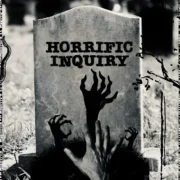Disability In Film Genres: Exploring The Body And Mind
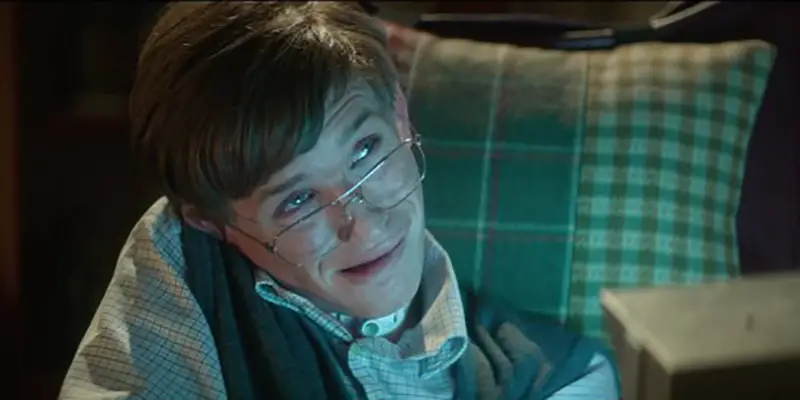
Sam is 25 years old from the West Midlands region…
Like all social groups, people with disability have been portrayed in diverse ways in Hollywood, from stereotypical representations in horror to genuine inspirations in melodramas. Disability is represented as a metaphor through imagery or characters’ features, or as a direct subject within the narrative. The entire concept of genre is recycled from elements within society, and the relevant features of each specifically labels the disabled into a certain character type. For example, a film about a man with clear physical disabilities is often depicted as an abject gaze within horror. This may be an unfair representation, but at the same time it is a relevant element of disability within genre.
From this, viewers can identify differences among characters as well as the thematic and visual styles, as the genre illustrates. Considering that some films do not directly state ‘disability’ or even consider it at all, it can still be used as a metaphoric code to illustrate a message (usually depending on the genre). For example, The Theory of Everything (2014) is a romantic-drama that represents disability as a battle, but also a source that can raise awareness and success. However, the accuracy of portrayal of disability in film has been criticised due to usually able-bodied cast and crew, who often cannot accurately depict the actual disability experience.
Disability is an interesting subject to discuss in this respect as it is an individual experience. The representations of people with disability within film genres are perhaps more diverse and genuine compared to representations of other groups such as women, minorities, and LGBT people. This article will thoroughly discuss representations of disability in each genre (action/adventure, animation, comedy, drama, horror, romance, science-fiction, war and western), and how we can identify them in specific film examples.
Action/Adventure
This particular genre is often crossed over with others, such as science-fiction or fantasy. In action film, disability is often represented as something that is considered traumatic and abject, or in contrast, as a source of power. It is often understood as a sense of loss in the sense of fewer bodily organs but also a sense of gain, particularly if a limb is replaced by something used as a tool.
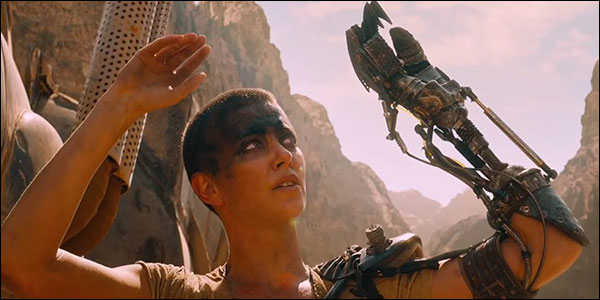
For example, in the Academy Award-winning film Mad Max: Fury Road, directed by George Miller, the female protagonist Imperator Furiosa (Charlize Theron) has a clear physical disability, as she only has one arm. She was born with two, but before the film’s events she had the left one amputated assumingly during combat. As a result, she has had it replaced with a metal arm, which, to an extent, minimises her status as disabled or deformed. She uses it as an arm and establishes it as part of herself, but due to its features she also uses it as a weapon.
Even when Furiosa isn’t wearing her metal appendage, notably during a brief fight with titular character Max (Tom Hardy), she is seen as a resilient woman who may be beaten down by losing her arm but is also strengthened by it, too. We do not find out how she lost her arm but we know it is a contributing factor to how powerful she is as a female heroine.
Other characters in Fury Road appear to have physical impairments that make them more powerful. The primary antagonist Immortan Joe (Hugh Keays-Byrne) has a breathing device shaped like teeth (similar to Bane in The Dark Knight Rises who, ironically, was played by Tom Hardy) and has a chest plate to protect old wounds. His sons also have physical conditions, including Corpus Colossus, played by Australian actor and disability activist Quentin Kenihan. Colossus has been described in the Mad Max novel series as “a man in a child’s body”. The other son is the giant Scabrous Scrotus (Travis Williamson), who was left scarred by Max, motivating him to get revenge.
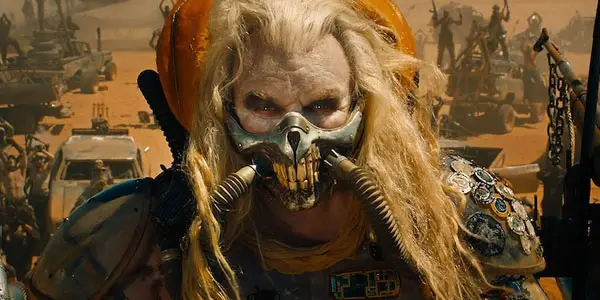
Action films do not strictly stereotype disability, as it distracts from whether we either sympathise with the characters or are disgusted by them. Instead, the genre presents physical impairments in a way that distinguishes a character as either a wounded hero or as a power-hungry, vengeful villain who uses replaced prosthetics to their advantage within the action.
Animation
Unlike any other genre discussed, animation stands alone in regards to that there is no physical performance involved in structuring characters. The animators or sketchers actually craft their images from drawings and computers, which in this case is disability. As animation is primarily meant for kids’ eyes, disability is conceptualised as a metaphor for the villain or as a subject for the hero. Walt Disney Pictures, in particular, have exemplified these ideas in both their early and contemporary animations.
Peter Pan (1953) features a world that is an alternate existence to normal society, called Neverland. Within that territory features the despicable Captain Hook, who appears disfigured with a hook for a lost hand which was previously eaten by a crocodile. Hook has always wanted revenge on Pan, and due to this angry motive he becomes villainous in personality as well as image. He may be considered a victim of Pan and the crocodile, but he maintains his antagonist status for how he treats everybody, including his faithful first mate Smee.
Captain Hook uses his hook as a weapon against his enemies, especially Peter Pan. In the cave scene he uses it to try and ‘claw’ Pan, but to no avail, as he falls off a cliff before hooking on to the ledge. This could be read as that he actually is a tasty fish baited by a hook on a fishing line, dehumanising him. Other than using the hook as a tool or as a symbol of revenge, Hook does use it as a hand. When he dresses up, he has his own hook-oriented gold cutlery set. They replace his traditional silver one and, interestingly, he places a ring on the gold hook, at least signalling a finger.
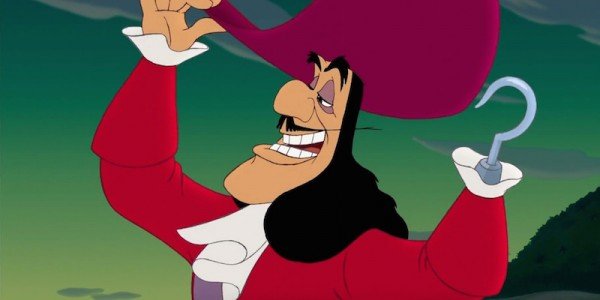
Another example from Disney is Dumbo (1941), a drama that depicts how a deformed elephant transcends from a freakish circus performer to a triumphant success. His name generally is referenced as “dumb”, especially compared to his mother Mrs. Jumbo. Most of the characters appear disgusted by Dumbo’s abnormally large ears, with the other elephants gasping at first sight and the circus crowd ridiculing him. At this stage, Dumbo is a delicate story about disability that may teach children about some harsh but somewhat truthful realities. Dumbo eventually realises his gift of abnormally large ears, further recognised by his mouse friend Timothy, in which he can fly using them. As a result, he becomes a phenomenon and stuns the audience.
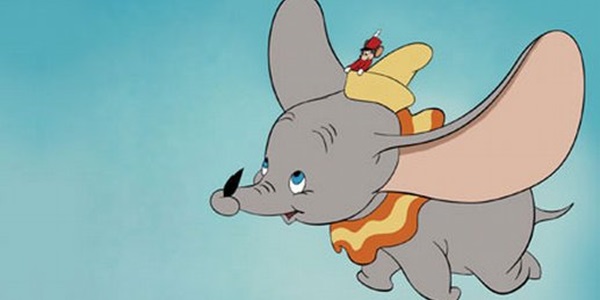
Finding Nemo (2003) also briefly addresses disability in a genuine manner. Nemo was born with one small fin after a pre-birth attack by a barracuda, which serves as a significant scar in relation to disability. His father Marlin considers it a disability by stating his concern to his new teacher, but Nemo remains self-confident about it. Dory is another disabled fish, as she suffers from short-term memory loss, a disability that is represented as humorous in the film but in the real world would be something genuine and personal.
The way in which animation and family films portray disability is, like in most film genres, as a metaphor and subject. However, because most of the genre’s films are targeted towards children, they may lean towards representing disability within a context friendly enough for children to enjoy and learn from.
Comedy
This particular genre is particularly cautious in its representation of disability in order to prevent portraying unfair stereotypes. This is often why there are not many comedies about physical disability – because it may inadvertently be interpreted as disrespectful and as a direct label. In this regard, comedy films usually focus on characters with mental disabilities. Mental disabilities appear ‘invisible’ – no physical ailments are shown.
Dumb & Dumber, for example, features mentally disabled protagonists, which contributed to the film’s success. The title in itself is a crack at the two heroes Lloyd Christmas (Jim Carrey) and Harry Dunne (Jeff Daniels) with “dumb” meaning one and “dumber” meaning the other. Lloyd, in particular, has developmental disabilities. However, the film does not deliberately contextualise this as a stereotypical portrayal because his mistakes and acts of stupidity are represented as slapstick humour rather than a disability. Therefore, the audience takes enjoyment from the humour as an entertainment asset rather than from a ridiculed viewpoint.

On the other hand, disability as inferior is stereotyped in other comedies. One of these is The Ringer, a story about a man named Steve Barker (Johnny Knoxville) who goes into financial debt and poses as a Special Olympics contestant in an attempt to repay the money. It sounds similar to Randle McMurphy (Jack Nicholson) posing as mentally ill person in One Flew Over The Cuckoo’s Nest, but The Ringer’s direct representation of disability is presented as comedy. Seeing able-bodied Barker/Knoxville actually pretend to be disabled among other actors who may be disabled in real-life can be interpreted as a stereotype and a prejudice.
However, some may argue that The Ringer represents the disabled as genuine individuals, with a message that we are all human and uphold general interests, hobbies and personalities. The idea of The Ringer being a stereotypical portrayal of disability could also come down to audience interpretations, particularly as leading star Johnny Knoxville’s acting history involved playing pranks and creating unconventional humour (such as his Jackass series).
Comedy often balances disability as part of the plot through either character features or directly subjected in the plot. Films like Dumb & Dumber and The Ringer appear to show disability with a message about their genuine values from a ‘normal’ person’s perspective, but also use symptoms of complex condition and apply them to meet elements of the comedy genre.
Drama
Out of any other film genre, drama films often represents disability at its most accurate, or at least attempts to from an actors’ point of view. Due to the key element of dramas having to emotionally engage the viewers, films that actually centre on disability are intentionally discussing the realities while presenting a sense of morality for the viewers. Dramas allow the audience to sympathise or feel emotionally engaged with the disabled protagonist, with the story being told in a triumph-over-tragedy structure. In other words, the plot makes us look back on the disability in order to move forwards.
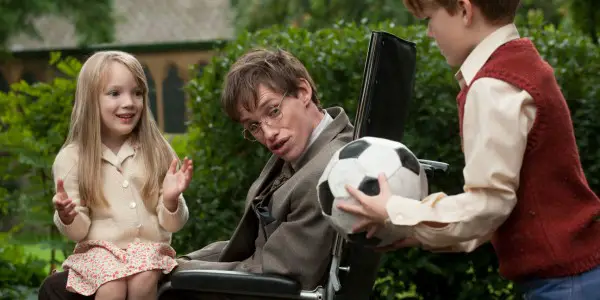
Arguably the clearest way for films to get the message across about disability is the biography. Certain figures such as Stephen Hawking and Christy Brown are inspiring figures in the industries they worked in, not only for their brilliance, but also for their disabilities. In My Left Foot and The Theory of Everything, we see two able-bodied actors, Daniel Day-Lewis (as Christy Brown) and Eddie Redmayne (as Hawking), two able-bodied actors who both thoroughly researched their roles, and had to physically transform into their characters in an attempt to pull off a convincing interpretation of their lives. This idea is actually considered a skill by many critics, and it is certainly acknowledged in terms of awards. Both Redmayne and Day-Lewis received Academy Awards for their performances.
Althoughdramas do not represent disability from an actually disabled point-of-view, the industry’s dedication and commitment help to promote the stories. Though it’s up for debate whether or not it’s fair to cast able-bodied actors for these roles, the films do acknowledge a story of disability, and raises the point that, as Stephen Hawking said, “we are all different. However bad life may seem, there’s always something you can do and succeed at.”
Horror
Arguably the first film genre that represented disability in its early years is horror. Hollywood portrayed traditional heroes and villains in a melodramatic context, with the former represented as a completely able-bodied person that defeats the threat. However, villains in horror cinema have usually appeared human, with a physical or mental disability represented as an abject space of disgust. Their image and personality traits, therefore, stand out in total opposition to the protagonist and appear inferior.
It can be argued that the appearance of a disabled individual in cinema dismisses entertainment value, particularly in horror films, due to their freakish image. In Frankenstein (1931), for example, the consequent experimentation led by obsessed scientist Henry Frankenstein (Colin Clive) is the unnamed “Monster” (Boris Karloff). His body is built from organs of different corpses, and an “abnormal brain” is accidentally implanted into his mind.
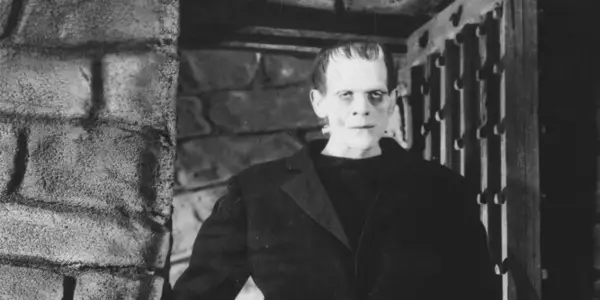
The Monster was also born via electricity, suggesting he is actually disabled. His physical appearance is disjointed, as features such as bolts in his neck and dull eyes do not make him completely human; thereby signalling his lack of bodily control and psychological understanding of identity and human interaction. Some even argue that these are symptoms of autism.
Although disabled characters in horror films become villains based only on their image, there are others that exemplify a traumatised past and a dark motive that make them the antagonist. Freddy Krueger (Robert Englund) in A Nightmare On Elm Street, for example, is a serial killer with not only severe burns but a razor-armed glove to use as a weapon. Krueger appears to have physical features of deformity, and is a burn victim, but his motive to kill children in their dreams makes him a deformed villain. Interestingly, though, Krueger appears to be more human and less of the freakish animal when he is not in the childrens’ dreams.
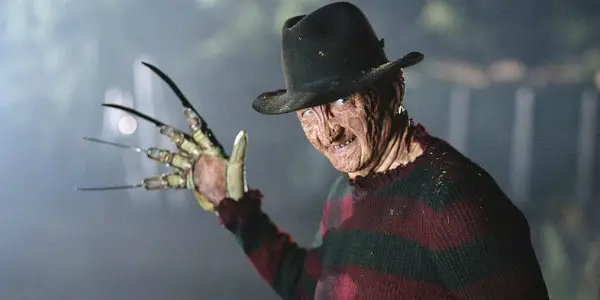
Horror films barely address disability at all, especially if portrayed as a narrative metaphor through themes and imagery, but both of those elements appear clear enough to tell viewers about how disability is portrayed. Horror films may stereotype disability to create villainous characters, but it is not directly associated with genre conventions, it’s only relevant when viewers notice the parallels.
Romance
This genre is a very delicate in its representations of disability, as its main emphasis is on relationships. It may be fair to say that there are not many romances involving disability, because some physical or mental characteristics may not blend into the genre elements of romance. In this respect, it has been easier to show disability in romance by showing its realities.
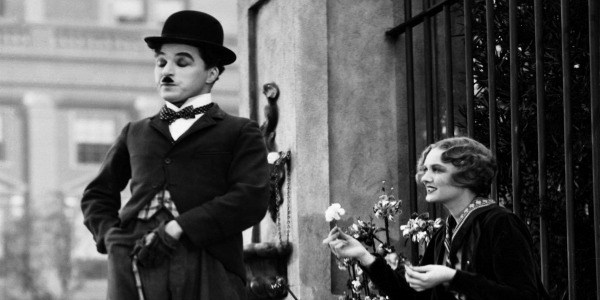
From a romantic standpoint, disability can be what holds somebody back to either express their feelings, or it can deteriorate their self-confidence. In City Lights (1931), for instance, the Tramp (Charlie Chaplin) quickly falls in love with a pretty flower girl (Virginia Cherrill) who is visually impaired. She is titled simply as “A Blind Girl” and falls into the stereotypical “sweet and innocent” representation of disability, which may suggest a sense of insecurity. However, as the subject of Tramp’s interest, she still consistently upholds her tender beauty and romantic values.
Other romance films represent disability in a stereotypical manner, such as Freaks (1932) by Tod Browning. Due to the real-life deformities of the actors, the film was originally released as a horror. However, it does misinterpret romance of disability while keeping its horror functions at the same time. The film has various subplots, but one that particularly strikes out concerning romance was between Hans (Harry Earles), a sideshow dwarf, and Cleopatra (Ogla Baclanova). The young woman is after the small, disabled man for his money. Cleopatra uses this strategy of romance as a tool, thereby using Han’s own emotions and insecurities against him.
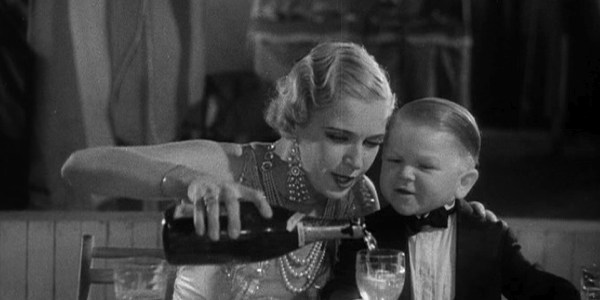
Despite the idea of romance demoralising or ridiculing the disabled, there are moments in cinema that show characters seeing past one’s condition as a romantic gesture. For example, The Elephant Man (1980) helps us understand that personality should rise above physical appearance, and John Merrick’s (John Hurt) intelligence provides that. In one sequence, Merrick exemplifies his intellect and romantic values by exchanging recitations of Romeo & Juliet with Mrs. Kendal (Anne Bancroft). She kisses Merrick’s cheek before telling him that he’s not an Elephant Man at all, but is Romeo. Romantic representations of disability may be portrayed in an unfair way (like Freaks) but, as City Lights and The Elephant Man indicate, cinema can also translate their realities, therefore establishing to viewers that anything is possible with true romance.
Coming soon is the romance film Me Before You, featuring a romance between a young disabled man and his caretaker, and we will see how disability is presented in romance in 2016.
Science-Fiction/Fantasy
Although often considered invisible within science fiction and fantasy cinema, there are metaphoric codes within the genres that are identifiable with disability. It is like this with action films and, to an extent, they do overlap one another. However, disability in science fiction and fantasy is particularly apparent through the nature of the characters themselves. Such aspects may involve technology and prosthetics as replacement for a character’s absent body parts, or the body itself that may function differently from an able-bodied one.
In the Star Wars series, for example, the iconic character of Darth Vader (voiced by James Earl Jones and physically performed by David Prowse) exemplifies disability as a metaphor in science fiction cinema. A New Hope originally portrayed Vader as a villain behind a mask, but after sequels Empire Strikes Back and Return Of The Jedi as well as the prequel trilogy (The Phantom Menace, Attack Of The Clones, Revenge Of The Sith) were released, we now think otherwise.
Originally, “Darth Vader” served as a name given, but future instalments reveal that his real name is Anakin Skywalker. Vader is his evil Sith alias and is a severely scarred and physically disabled villain, while Anakin is his humane identity as a Jedi Knight in a physically able body. Viewers may now understand Vader, particularly in Return of the Jedi, as a man who clearly wasn’t in the suit to begin with. His new identity as the father of Luke and Leia already indicated that he was once able-bodied, but as he became evil, he also became disabled. In this sense, the entire Star Wars saga (until The Force Awakens) centres on Vader/Anakin, with an overarching narrative theme of his transition from good to bad that was also his progressive path from able-bodied to evil and severely scarred.
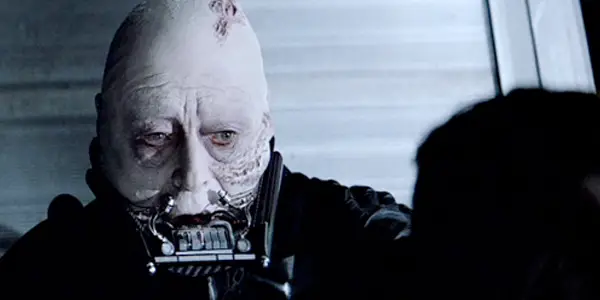
Anakin became Darth Vader by temptation of Chancellor Palpatine in Revenge Of The Sith, but he became disabled and severely deformed in that film’s climatic, fiery duel with Obi-Wan Kenobi. When unmasked from the helmet after decades, he suddenly becomes the humane Anakin Skywalker and is identified as a scarred man trapped in Darth Vader’s mechanical body. The idea is that Anakin’s able-bodiedness is represented as ‘good’, while Vader’s suit featuring metal prosthetics and breathing mask are portrayed as ‘evil’. Therefore, the disability is stereotypically portrayed as inferior.
Another example is Avatar. Jake Sully (Sam Worthington) is left disabled and wheelchair-bound after having gone to war, but when arriving on Pandora, he is assigned to be linked to a Na’vi body to “claim his legs back”, as antagonist Colonel Quaritch (Stephen Lang) put it. The film represents humanity as both morally and physically weak, while portraying the Na’vi culture as awe-inspiring and pure, though many of the human characters consider them savages.
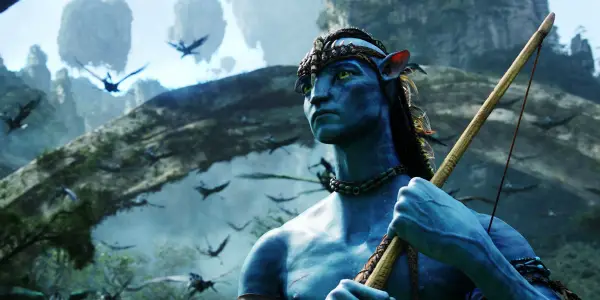
Technology is an element of the science fiction genre, and aspects of it (specifically the Avatar Program) are the tools which grant Jake’s physical transformation from human body to Na’vi. The film’s production shows this, too, with stars Worthington, Zoe Saldana, Sigourney Weaver and others using motion-capture for their performances in Na’vi bodies. Jake makes the decision to transform from his wheelchair-bound human body into the able-bodied Na’vi. Originally serving as a mission from Quaritch, Jake begins to learn about the Na’vi culture while simultaneously restoring the physical power he has newly gained in this new and unorthodox body. Although he eventually decides to ally with the Na’vi against the humans, he does “get his legs back” within the new body. Jake’s identity does not change, but his body does.
Whether science fiction and fantasy cinema stereotype disability is primarily down to viewers’ own interpretation, but we establish that when connecting both human and robots or extra-terrestrials, it may accidentally be interpreted as a label. It is apparent either through a character’s unusual functioning of body or mind, but the escapist reaction viewers get from science fiction and fantasy often distracts from the metaphoric hints of disability.
War
The entire concept of war today involves suffering with severe consequences, often resulting in horrendous injuries or death. The same analogy can be found in cinema’s portrayal of war and its genre representations of disability. Viewers understand that war cinema often depicts able-bodied soldiers who were either physically beaten or mentally traumatised from the horrors of war. They may be left as physically handicapped or mentally ill after war. In specific films, such as Forrest Gump (1994) and Born on the Fourth Of July (1989), we follow characters who have suffered critical injuries leaving them disabled, and their attempt to relive their lives back at home.
Forrest Gump, as a whole, touches on developmental and physical disability through its titular character, Forrest (Tom Hanks). However, the film features another supporting character who exemplifies the consequence of war in relation to disability – Lieutenant Dan Taylor (Gary Sinise). Before his disabled condition, he was an able-bodied leader of an American platoon in Vietnam, but after getting shot in both his kneecaps, his legs were amputated. Dan is ashamed and calls himself “a legless freak”. He considers himself to be not only physically beaten but also psychologically; hence his new look with long, messy hair in a wheelchair. He has become an alcoholic, but Forrest still continuously calls him “Lieutenant” Dan.
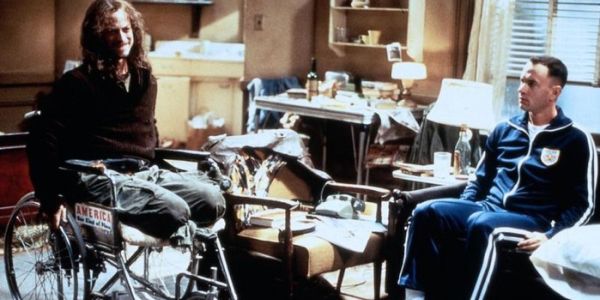
Despite Dan’s struggles with having no legs, he accompanies Forrest on his shrimp boat, and years later attends Forrest and Jenny’s wedding as a new man. He appears to be wearing a suit with a clean haircut and shave, and he has prosthetic metal legs that help him stand across Forrest.
War films do not represent disability as something that is stereotypically inferior compared to a “pure” soldier, but shows their humane qualities in a both physical and psychological way. The injuries of war do not always weaken a character but instead show the realities of life, and that injuries and lives can be rehabilitated after combat.
Western
Westerns may be the one genre that has very few representations of disability, which could be due to the fact that it does overlap other categories. However, there are still aspects of disability to be found in westerns. First, westerns show both a historical viewpoint of mainly the American wilderness and its cultural neighbours, some of whom are labelled as antagonists and savages. In regards to disability, westerns often feature characters who are either able-bodied but are absent of a vital organ or are physically disabled altogether.
Westerns are often associated with war, action and drama but we see that certain western genre conventions (such as cowboy hats, boots, guns, belt buckles and general wilderness setting) can associate with disability in specific film examples. For example, in True Grit (1969), its sequel Rooster Cogburn (1975) and the 2010 remake, the protagonist Rooster Cogburn (John Wayne/Jeff Bridges) has a missing eye and is seen wearing a patch following the fight during the American Civil War. The meaning of both this prop and Rooster’s missing eye is that he represents himself as a wounded antihero but also as a man of the law. He appears to be wounded, enhanced further by his image, but the outcast settings of the American wilderness may further contribute to it (as an outcast from a normal society).
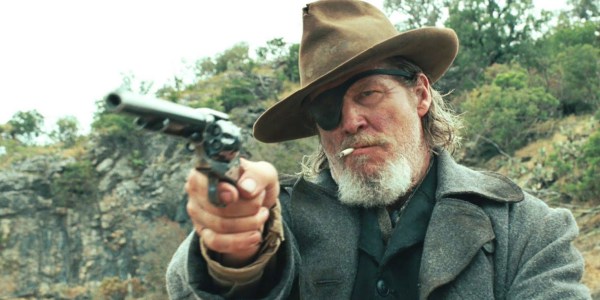
Disability representations in western cinema are not always as evident or metaphoric compared to the other genres discussed. However, the interesting concept of westerns in relation to disability representations are that, through imagery and character development, they exhibit a dichotomy between disability as villainy and disability as physically wounded. Rooster may strike a villainy outlaw image due to his eye patch, but with this information and his unorthodox motives, he still is loyal to the American government. “True grit” generally refers to Rooster in both his appearance and personality, but it is also a term that ultimately describes westerns and could connect to disability.
Conclusion
As evident throughout this article, disability representations in cinema vary across different genres, specifically from their different elements, themes and character types. There are some which are similar (such as action and sci-fi, or romance and comedy) but, as I have demonstrated, disability is represented in its own way in each genre.
These depictions can be interpreted as either a stereotypical or promotional representation of disability by centering on their physical image, psychological mindset, or their lifestyles and drawbacks relating to their condition. How these are translated from a screenplay to the big screen is primarily down to meeting genre elements, although not all stereotypical representations are deliberate (such as in science fiction/fantasy and horror).
Portrayals of disability in cinema have progressively become more open across various genres, and the film industry encourages them. Particularly concerning dramas and romances (genres which arguably depict the disabled experience most accurately), the idea has been that disability is not always synonymous with disease. Conditions may not be curable but, as exemplified from film examples and as evident in general society, they can be rehabilitated.
Which disabled character is your favourite? What do you think about how people with disability are portrayed in film?
Does content like this matter to you?
Become a Member and support film journalism. Unlock access to all of Film Inquiry`s great articles. Join a community of like-minded readers who are passionate about cinema - get access to our private members Network, give back to independent filmmakers, and more.
Sam is 25 years old from the West Midlands region of the UK, who has a passion for the world of cinema and publishing. He is currently studying a postgraduate degree in Film & Television: Research and Production at the University of Birmingham. He is currently working in theatre and academic support.













